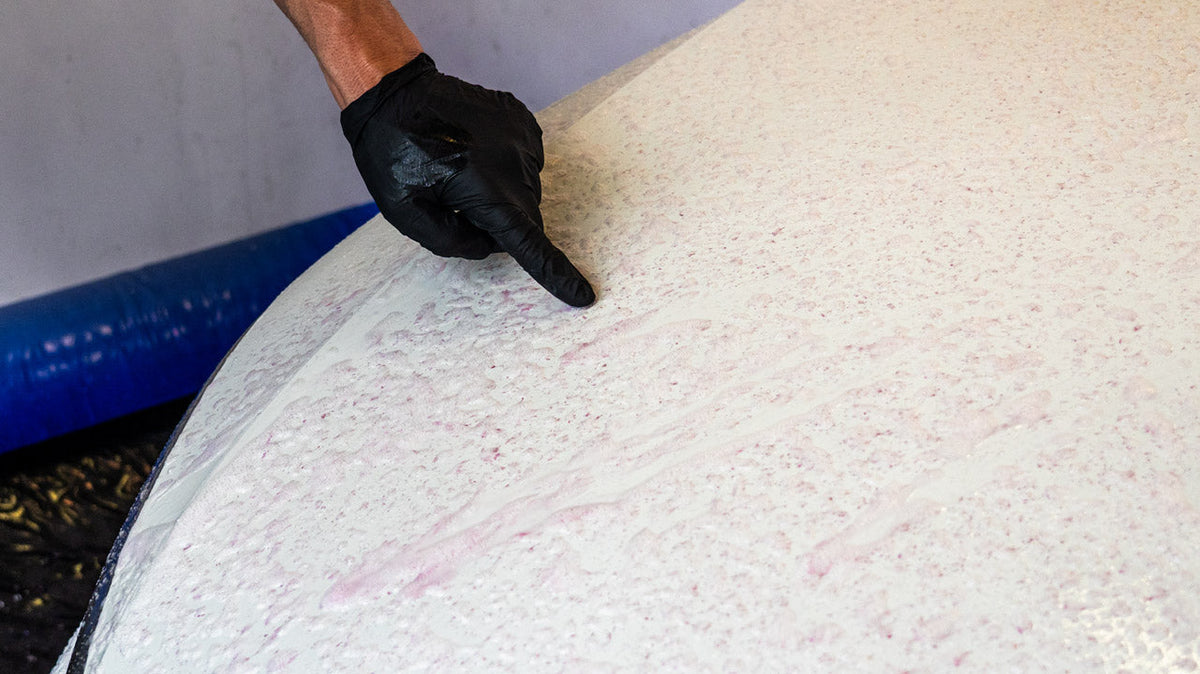The pre-wash and washing action cannot remove all the contaminants present on the bodywork.
Some of them, such as iron and tar particles, have the ability to penetrate the pores of the paint and therefore require a specific action to obtain a perfect surface so called chemical decontamination auto .
DECONTAMINATION OF FERROUS / RUST PARTICLES.
- Spray a ferrous decontaminant such as D1 Iron (diluted 1: 1-1: 2) or UltraCoat Iron + on the surface evenly.
- Let the detergent act.
The change in color of the product is the sign that the decontaminant is actually acting on the iron particles present.
- Wait about 4/5 minutes and rinse thoroughly with water, preferably at high pressure, preventing the product from drying on the surface.
DECONTAMINATION GLUE AND TAR.
- Spray the product D3 Tar on the surface evenly.
- Leave the detergent to act for 2 or 3 minutes.
The glue and / or tar stains will begin to disintegrate. If the dirt is persistent, intervene with a glove or microfiber and work the product delicately without pressure.
- Rinse thoroughly with water, avoiding that the product dries on the surface.
LIMESTONE OR ACID RAIN DECONTAMINATION.
- Spray the product DS Scale (either in foam or pre-diluted in a spray with distilled water) on the surface evenly, proceeding by sections.
- Use a delicate glove such as Innovacar Wash Mitt , Profipolish Wash Mitte Deluxe , spreading the product evenly on the surface to facilitate the removal and dissolution of dirt.
- Rinse thoroughly with water, making sure the product does not dry on the surface .
Recommendations:
- It is important that the product does not remain on the glass for long.
- It is advisable to use the product about every 3 washes as a foam shampoo to maintain the Sealant (for example SC1 Sealant or SC0 Hydro sealant ).
AND AFTER DECONTAMINATION?
It's time to use the clay bar !
The clay bar is used to remove all those impurities that are still present on the surface, even if not visible to the naked eye.
In the case of a simple washing it could be useful to add a layer of sealant or wax ( SC0 , SC1 ), or use a quick cleaner ( W1 Quick Detailer ) to increase brightness and intensity.
WHAT IS IT (AND WHERE) TO USE THE CLAY BAR.
Passing the clay bar on the paint allows you to remove all impurities (and not to remove scratches and marks from the paint, as is often thought), present after the washing.
The result obtained will be that of a perfectly smooth surface.
The clay bar can be used on all smooth surfaces (glass, lights, rims and glossy paint), to be avoided are surfaces such as gaskets, unpainted plastics and opaque paints
HOW MUCH AND WHEN?
The clay bar should be used a couple of times a year if you decide to protect the car with a wax lasting a few months, or in the case of particular cleaning problems on the paint.
An excellent way to understand if the surface needs to be decontaminated can be the bag test:
- Carry out the prewash of the car and the washing.
- Take a plastic bag such as those used in the kitchen for storing food to use as a "glove".
- Rub the surface to be analyzed with the fingertips.
- If we find a rough surface, it is necessary to act with the clay bar!
CLAY BAR: AS.
- Choose the suitable clay bar .
The clay bar heavy is the best solution in 90% of situations thanks to its cleaning capacity.
However, there are cases, such as for use on historic cars and with particularly delicate paints, in which a more delicate action clay bar soft is recommended.
- Wash and dry the vehicle.
- Wet with the lubricant ( DL Lube ) and flatten the clay bar with your hands.
- Work on small sections, about 40 X 40 cm, spray the lubricant for the clay on the work surface evenly.
- Spray the lubricant also on the clay bar and pass it gently on the work surface with overlapping steps.
In the presence of particularly stubborn impurities, repeated steps may be necessary.
Try to reshape the clay in order to maintain a fresh and dry surface .
- Continue to work on the same area until all impurities are removed.
Upon reaching an optimal result, the clay will flow smoothly on the surface.
- Remove excess lubricant with a dry microfiber cloth.
- Repeat steps 3 to 6 until the entire car has been properly worked with clay.
- Once the work is finished, put the clay bar away and spray it with lubricant in order to keep it soft and flexible.
- Then proceed with a quick car wash before polishing or applying the sealant.
N.B. we do not recommend carrying out a mechanical decontamination (with the use of claybar) where the car is new or in excellent condition, as it could create micro scratches and halos that would inevitably lead to a polishing to be able to remove them. In these cases we recommend carrying out only a chemical decontamination with ferrous decontaminant and a tar / glue / resin remover (possibly present).
